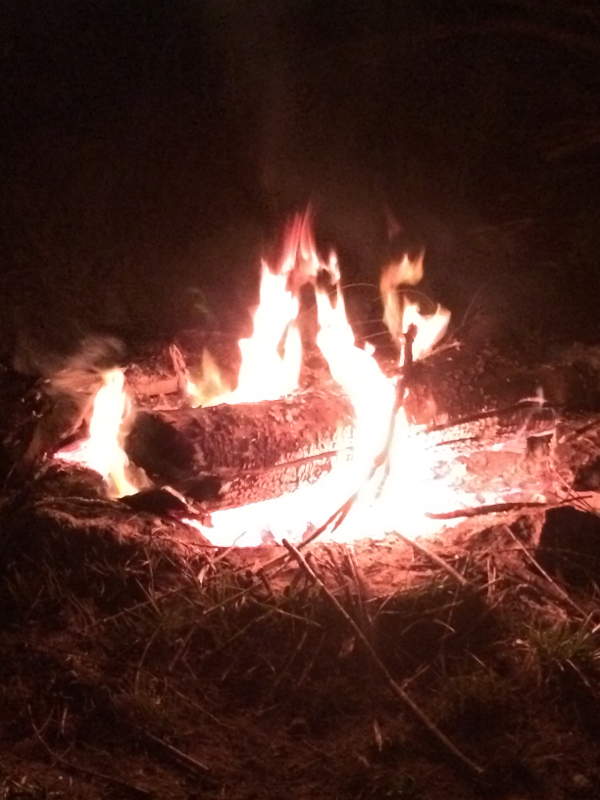“The light that burns twice as bright burns half as long — and you have burned so very, very brightly, Roy. Look at you: you’re the Prodigal Son; you’re quite a prize!” -Dr. Eldon Tyrell, Blade Runner
Some questions that we look at are fun to consider because of how far outside our own experience they are, but others are fun for the exact opposite reason: because they ask about a very common phenomenon whose explanation isn't so simple!
Think about fire, for example, and why a campfire with a single large log on it takes a certain amount of time to burn, but the identical fire with one or two extra large logs on it -- theoretically, with more fuel to burn -- actually burns out more quickly!
 Image credit: Fire with one big log on it, via http://www.itsjustanopinion.com/5/post/2014/04/spring-time.html.
Image credit: Fire with one big log on it, via http://www.itsjustanopinion.com/5/post/2014/04/spring-time.html.
Why is that? Find out on this week's down-to-Earth Ask Ethan!


And thus, as noted by Ethan elsewhere, we find the most massive stars dying first and the faintest red dwarfs outliving the superluminous galactic beacons that are O & B stars by many trillions of years.
Staggering but true that this is so extreme that every red dwarf ever formed is still shining albeit so dimly not a one can be seen without optical aid* but many of the brightest blue O& B stars plus the supergiants blue, yellow white and red were not yet born when dinosaurs ruled our Earth.
* Possible rare flare activity excepted -there was one that briefly reached unaided eye visibility due to flare activity I gather -and no it wasn't Proxima or Barnard's Star or even Luyten's Flare Star UV Ceti!
Nope it was EV Lacertae - see :
http://blogs.discovermagazine.com/badastronomy/2008/05/19/the-red-dwarf…
Plus possibly a few other M-dwarfs similarly if very, extraordinarily rarely can achieve this feat.
***
The blue supergiant star Rigel A emits more light in a minute than the Sun does in a month and is the most radiant star of all within 1,000 ly radius of the Sun. (Exact quote : “Of the 10 million stars within 1,000 light years of earth, Rigel ranks as number 1, radiating more light than any other. Each minute it [Rigel] casts off more light than the Sun generates in a month.”
-Ken Croswell, “The Blue Witch” p. 22 in ‘Sky & Telescope’ magazine May-June 2007.
I guess we should "thank our lucky stars" that our stellar mass is no higher than what it is.
Imagine evolving to this point on a habitable planet with a larger sun. Once you comprehended the science of stellar evolution, the awareness of imminent doom would drive home the necessity of rapid technological advancement, with the goal of getting folks the hell out town soon, and moving them very far away.
Re. Mando Zink: None the less, in a half billion years our Sun will increase in luminosity to the point where life ceases on Earth.
For this reason we are morally obligated to achieve a sustainable civilization that continues to expand its capacity for space travel. With that, the time will come when we or post-we can migrate to other star systems, and have sufficient time to do so.
The capacity to become a cosmic civilization depends directly on achieving sustainability on Earth. So even if a half billion years seems like the far, far future, the fact is that what we do in our lifetimes will have a direct effect on those who will live in those times.
"Do unto the future, as you would have the past do unto you."
Your 'flame' article appears, and I am this morning well into the 'House-Warming' chapter of Rouseau's Walden', 1854, a wonderful book, of his time in the woods near Concord, MA in the 1840s. And what did I read?
'a raft of pitch-pine logs, with the bark on, pinned together by the Irish when the railroad was built. This I hauled up partly on the shore [of the pond]. After soaking two years and then lying high for six months it was perfectly sound, though waterlogged past drying ... Though completely waterlogged and almost as heavy as lead, they not only burned long, but made a very hot fire; nay, I thought that they burned better for the soaking, as if the pitch, being confined by the water burned longer, as in a lamp.'
Stellar evolution of an individual star is counterinutuitive. As a sunlike star core depletes its hydrogen (replacing it with Helium) the campfire analogy would cause one to think the reaction would slow down, and the star gradually cool and become less luminous. Exactly the reverse happens, as the equilibrium between gravity and heat and heatflow and nuclear energy production shifts towards a denser/hotter core burning the now poorer fuel even faster.
Considering the two logs side by side, the mutual radiation would increase the burn rate considerably, compared to the single log.